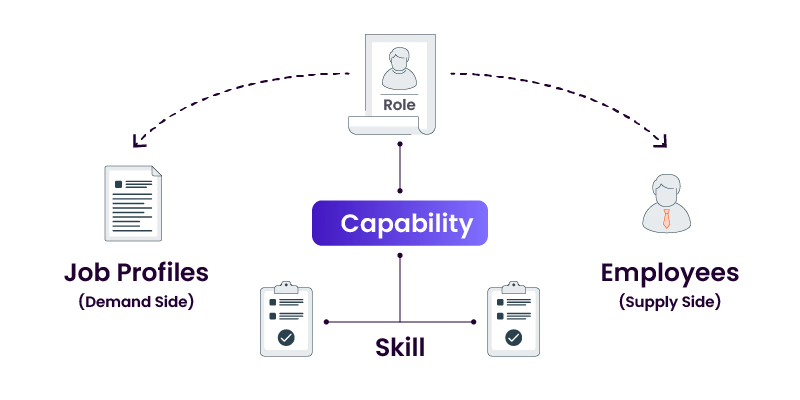Structure First, Strategy Next: Get Your Skills in Order with Ground-Up Taxonomy
A ground-up skills taxonomy lays the foundation for a truly skills-first organization. Learn how to structure skills data from scratch to drive impactful outcomes across upskilling, internal mobility, and workforce planning.
What Makes a Skills Taxonomy Truly Work for You?
A Ground-Up Taxonomy is a dynamic, AI-curated hierarchy of skills, roles, and capabilities, built organically from the internal context of an organization — not imposed from external or academic libraries.

Instead of relying solely on top-down standards, a Ground-Up Taxonomy captures the real language of work — how skills are used across job profiles (demand side) and how they show up in employees (supply side).
Why Top-Down Doesn’t Work Anymore
Modern enterprises are evolving rapidly. Business models shift, technology stacks expand, and talent demands change overnight. Generic taxonomies simply can't keep up.
A Ground-Up Taxonomy:
- Reflects reality: Mirrors actual job requirements and workforce skills.
- Drives agility: Evolves with business needs and market signals.
- Enables personalization: Powers employee-centric career paths and learning journeys.
- Supports talent analytics: Offers precision in skill gap, supply-demand alignment, and mobility.
- Enforces alignment: Connects business, HR, L&D, and technology under a shared skills framework.
How iMocha Builds a Taxonomy That Evolves With You

Step 1: Demand-Side Inference from Job Profiles
- Parse job descriptions, roles, and capabilities.
- Infer required skills, proficiencies, priorities.
- Map skills to business goals and deliverables.
Step 2: Supply-Side Inference from Employees
- AI parses resumes, certifications, project artifacts, and learning records.
- Infers actual skills, proficiency levels, and context of use.
- Builds a holistic skill graph for every employee.
Step 3: Match, Map, and Govern
- Align supply and demand with role-based skill mappings.
- Highlight gaps, overlaps, and surpluses.
- Surface adjacent skills for career pathing and redeployment.
Running a Taxonomy That Never Stalls
Creating a taxonomy is not a one-time event. iMocha empowers ongoing governance with built-in AI tools:
🔍 Discovered Skills
Continuously surfaces new and evolving skills from real-time data — ensuring your taxonomy mirrors actual capability trends.
🙋♀️ Employee Skill Request Workflow
Crowdsources insights from employees while maintaining admin governance — enabling democratized yet controlled evolution.
🧹 Orphan Skill Analytics
Flags unused or misaligned skills that aren’t connected to roles or capabilities — ensuring taxonomy hygiene.
📈 Skill Trend Analytics
Reveals which skills are rising or fading across job families — helping orgs stay market-relevant.
⏰ Governance Reminders & Nudges
Triggers periodic review workflows for stale job profiles or low-usage skills — maintaining freshness and relevance.
📊 Taxonomy Health Score
Provides a quantifiable metric for taxonomy coverage, usage, and aging — guiding administrators where to act. (Coming soon: AI-driven scoring logic based on adoption, currency, and completeness.)
🛡 Skill Audit Log
Maintains a traceable log of skill additions, deletions, and changes — building accountability and transparency.
🌍 Market Benchmarking
Compares internal taxonomy against market standards and external data — highlighting gaps and innovation opportunities.
Success Story: How a Global Bank Turned Skills Chaos into Competitive Advantage
Industry: Banking & Financial Services
Employees Impacted: 5,000+
Challenge
The client aimed to shift to a skills-based operating model. Existing libraries were too broad, failing to capture mission-critical and future-ready skills.
iMocha Solution
- Job Role and Skill Mapping
- Mapped skills for every role across business units and product lines.
- Created a living job architecture aligned to business strategy.
- AI-Driven Employee Profiling
- Inferred employee skills from resumes, certifications, project records.
- Built dynamic skill profiles with proficiency levels.
- Certification Integration
- Ingested certification data to enhance skill validation.
- Used confidence scoring for precise, contextual inference.
- Business Validation Loops
- Embedded business leaders in review cycles.
- Ensured adoption and operational credibility.
- Dynamic Taxonomy Evolution
- Enabled taxonomy to auto-adapt to product and market changes.
- Powered continuous workforce intelligence.
Outcomes & Impact
- ✅ Business-Aligned Taxonomy: Grounded in reality, tailored to workflows and tools.
- ✅ AI-Powered Precision: Enabled targeted upskilling and redeployment.
- ✅ Cross-Functional Trust: HR, L&D, and business leaders co-owned the transformation.
- ✅ Predictive Intelligence: Guided workforce planning and talent mobility decisions.
- ✅ Living Taxonomy: Evolved into a strategic capability — not just a static database.
“This isn’t just a taxonomy—it’s the engine behind our skills-first transformation.”
— Head of Talent Transformation, Financial Services Client
Start Building the Skills Engine Behind Every Talent Decision
With iMocha, building a Ground-Up Taxonomy is just the beginning. We empower you to govern, evolve, and activate your skills architecture — across talent acquisition, development, and planning.
Let’s co-create the skills foundation for your future-ready enterprise.
📩 Connect with iMocha to unleash the next-gen skills operating model — at scale, speed, and precision.


.avif)
.webp)

.webp)


